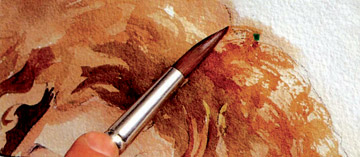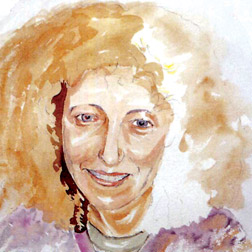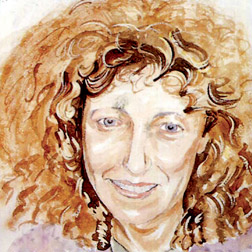Drawing and painting skin and hair
 The painting of the skin is an advanced value related study. The
colour of the skin, is one of the complicated challenges in watercolour
of all textures. Skin is the most subtle and elusive, and painting it so
that it looks alive is one of the greatest of challenges to a painters
skills. The painting of the skin is an advanced value related study. The
colour of the skin, is one of the complicated challenges in watercolour
of all textures. Skin is the most subtle and elusive, and painting it so
that it looks alive is one of the greatest of challenges to a painters
skills.
Texture of the skin
While the skin is young, it reflects the light uniformly and with
precise highlights. In contrast when the skin becomes older, its texture
no longer reflects light uniformly but intensifies the texture and the
shadows cast by the wrinkles over the features of the face. The most
dramatic changes in the texture of skin are wrought by time; the skin of
a baby or a young child is soft and ‘peachy’ while that of an old
person, especially one who has spent a lifetime working out of doors,
can often resemble leather or hide. But this not all – the texture also
varies according to the part of the body.
 |
|
How to
paint skin |
 In an adult, hands and faces constantly exposed to the air are nearly
always rougher than the torso covered by its protective layer of
clothing for most of the time. In an adult, hands and faces constantly exposed to the air are nearly
always rougher than the torso covered by its protective layer of
clothing for most of the time.
The ever changing appearance of skin has fascinated painters for
hundreds of years. For Leonardo da Vinci (1452-1519) in his day worked
only from live models.
Although many successful portraits and figure paintings done in
watercolour, it is not the easiest medium to handle for a subject that
is difficult in any case, and beginners in watercolour would be well
advised to practise before embarking on a human subject. It demands a
clear and direct approach, particularly when it comes to rendering the
subtle texture of skin.
In watercolour
The translucent quality of young skin can often be conveyed by
painting wet-in-wet so that colours and tones blend into each other, but
for older skin, with a more lined and opaque appearance, you will need a
technique which gives more control, especially when it comes to the
detail.
Instead of broad washes, the texture and form are perhaps best
conveyed by broken areas in which the brush is applied in individual
touches. Remember, though, that each small wash or brush stroke creates
a slight hard edge, so keep these to a minimum by building up gradually
and avoiding strong tonal contrasts.
Textures in hair
 |
 |
|
How to
paint hair |
There is such a range of textures and styles seen on the human head
that it is impossible to generalize about them, but there are some
points to bear in mind when you are drawing or painting. The most
important is to ensure that you relate the hair to the head itself.
This sounds obvious, but if your subject has an elaborate hairstyle,
it is only too easy to become so involved in the intricacies of curls
and waves that you forget about the skull beneath and the way the hair
relates to the face.
Look for the weight of the hair, too, as this is important in giving
shape to the style, even in the case of short hair. All hairstylists
know that thick, heavy hair holds its shape better than thin, heavy hair
holds its shape it has the easier, it is to paint. You can simplify the
forms, using long sweeping brush strokes that follow the flow of the
hair. Another quality to look out for is the sheen of the hair. For any
artist or a beginner this is the most important characteristic of all,
the highlight giving the vital textural clues. Dark oily hair will have
very pronounced highlights; thick, dry hair diffused ones, and thin, dry
or frizzy hair almost not recognizable highlight.
Effective methods
Pencil is an easier medium for drawing skin and hair because of its
ability to capture the softest nuance of tone and to express fine lines
and rhythms.
For long hair sharpen the pencil to a fine, tapering point so that
there is plenty of exposed led and draw using the side and the point of
the lead. Use a soft 2B pencil to begin with, and hold the pencil in a
way that will give a sweeping rhythm without feeling restricted.
For short, curly hair, try a light scribbling motion. Use fairly a
thick drawing paper and begin the drawing by impressing those strands of
hair you want to reserve as white. By practicing many times he could get
the desired results.
www.tissahewavitarane.com
|



